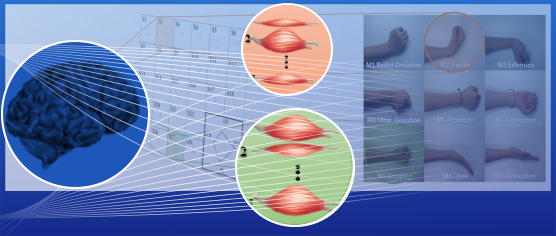H. Han and S. Jo

This work suggests a supervised hierarchical Bayesian model for surface electromyography (sEMG) signal based motion classification and its strategy analysis. The proposed model unifies the optimal feature extraction and classification through probabilistic inference and learning by identifying the Latent Neural States (LNSs) that govern a collection of sEMG signals. In addition, the inference step provides an approach to identify distinct muscle activation strategies according to sEMG patterns based on LNSs. To validate the model, nine-class classification using four sEMG sensors on the limb motions is tested. The model performances are evaluated with relatively high and low activation levels, generalized classification across subjects and online classification. The model based on LNSs to capture various motions is assessed with respect to activation levels, individual subjects and transition during online classification. The proposed model can reflect various muscular activation patterns across subjects as well as represent subject-specific characteristics of muscular activities. Such potential functions will promote the feasibility of the proposed model for applications. Our approach can not only classify sEMG patterns but also provide the interpretation of sEMG strategic patterns. This work supports the potential of the proposed model for sEMG control-based applications. Furthermore this work proposes that the hierarchical Bayesian model is a natural, intuitive and efficient means for myoelectric assistive device interface or control development.
Tags: Classification, electromyographic control, supervised hierarchical Bayesian model, surface electromyography (sEMG)

